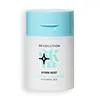What's inside
What's inside
 Key Ingredients
Key Ingredients

 Benefits
Benefits

 Concerns
Concerns

No concerns
 Ingredients Side-by-side
Ingredients Side-by-side

Water
Skin ConditioningCaprylic/Capric Triglyceride
MaskingCoco-Caprylate
EmollientGlycerin
HumectantCetearyl Alcohol
EmollientButyrospermum Parkii Butter
Skin ConditioningCetyl Alcohol
EmollientGlyceryl Stearate
EmollientPropanediol
SolventStearic Acid
CleansingCeteareth-20
CleansingPhenoxyethanol
PreservativeHydroxyethyl Acrylate/Sodium Acryloyldimethyl Taurate Copolymer
Emulsion StabilisingSqualene
EmollientCocos Nucifera Oil
MaskingTocopheryl Acetate
AntioxidantXanthan Gum
EmulsifyingAvena Sativa Kernel Flour
AbrasiveC12-15 Alkyl Benzoate
AntimicrobialDimethicone
EmollientSodium Gluconate
Skin ConditioningPolysorbate 60
EmulsifyingEthylhexylglycerin
Skin ConditioningSodium Hyaluronate
HumectantWater, Caprylic/Capric Triglyceride, Coco-Caprylate, Glycerin, Cetearyl Alcohol, Butyrospermum Parkii Butter, Cetyl Alcohol, Glyceryl Stearate, Propanediol, Stearic Acid, Ceteareth-20, Phenoxyethanol, Hydroxyethyl Acrylate/Sodium Acryloyldimethyl Taurate Copolymer, Squalene, Cocos Nucifera Oil, Tocopheryl Acetate, Xanthan Gum, Avena Sativa Kernel Flour, C12-15 Alkyl Benzoate, Dimethicone, Sodium Gluconate, Polysorbate 60, Ethylhexylglycerin, Sodium Hyaluronate
Ingredients Explained
These ingredients are found in both products.
Ingredients higher up in an ingredient list are typically present in a larger amount.
This ingredient is an emollient, solvent, and texture enhancer. It is considered a skin-softener by helping the skin prevent moisture loss.
It helps thicken a product's formula and makes it easier to spread by dissolving clumping compounds.
Caprylic Triglyceride is made by combining glycerin with coconut oil, forming a clear liquid.
While there is an assumption Caprylic Triglyceride can clog pores due to it being derived from coconut oil, there is no research supporting this.
Learn more about Caprylic/Capric TriglyceridePhenoxyethanol is a preservative that has germicide, antimicrobial, and aromatic properties. Studies show that phenoxyethanol can prevent microbial growth. By itself, it has a scent that is similar to that of a rose.
It's often used in formulations along with Caprylyl Glycol to preserve the shelf life of products.
Sodium Hyaluronate is hyaluronic acid's salt form. It is commonly derived from the sodium salt of hyaluronic acid.
Like hyaluronic acid, it is great at holding water and acts as a humectant. This makes it a great skin hydrating ingredient.
Sodium Hyaluronate is naturally occurring in our bodies and is mostly found in eye fluid and joints.
These are some other common types of Hyaluronic Acid:
Learn more about Sodium HyaluronateWater. It's the most common cosmetic ingredient of all. You'll usually see it at the top of ingredient lists, meaning that it makes up the largest part of the product.
So why is it so popular? Water most often acts as a solvent - this means that it helps dissolve other ingredients into the formulation.
You'll also recognize water as that liquid we all need to stay alive. If you see this, drink a glass of water. Stay hydrated!
Learn more about Water